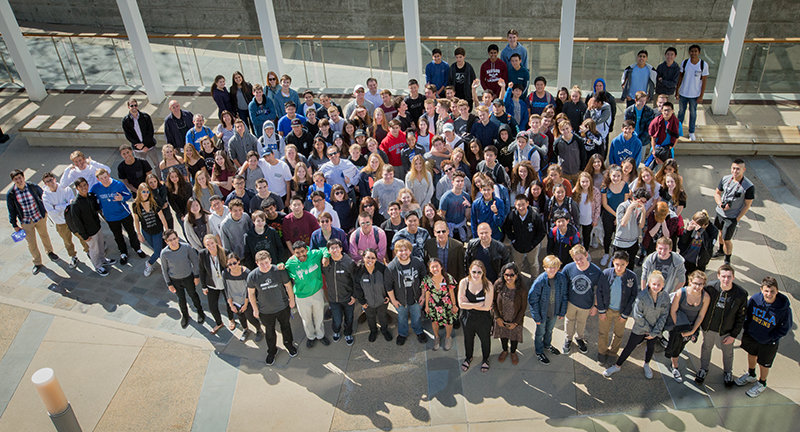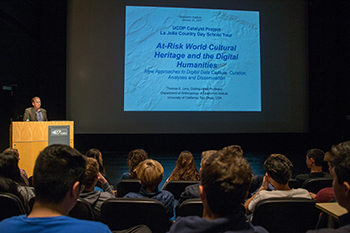Middle, Senior High Students Visit Ancient Sites in 3D at UC San Diego - Without Leaving La Jolla

San Diego, February 13, 2017 — The Center for Cyber-Archaeology and Sustainability (CCAS) and the Qualcomm Institute played host to nearly 200 students on the UC San Diego campus from the neighboring La Jolla Country Day School.
On January 31, the entire freshman class and students in Computer Science, Robotics and AP World History made the trek to Atkinson Hall, the headquarters building of QI (named for former UC President and UC San Diego Chancellor Richard C. Atkinson, who still maintains an office in Atkinson Hall).
QI Director Ramesh Rao welcomed students to the Calit2 Auditorium. “Human imagination is our greatest resource,” said Rao, urging students to use their imagination and keep asking questions. The electrical engineer also described a new project his team is working on: a wireless brain modem, part of the NeuroGrain initiative.

Rao then introduced CCAS Director Thomas E. Levy – a Distinguished Professor of Anthropology and Archaeology at UC San Diego – who also leads a variety of archaeology projects that have helped the Qualcomm Institute become a pioneer in the field of cyber-archaeology, which he calls “the marriage of archaeology, computer science, engineering and the natural sciences”. As he told the La Jolla Country Day students, CCAS is a new center that aims to provide “21st-century solutions to safeguard the past for future generations.”
Among those projects, Levy leads the high-profile At-Risk World Cultural Heritage and Digital Humanities project funded by the University of California Office of the President Catalyst program. The project brings together archaeologists based at UC San Diego, UCLA, UC Merced and UC Berkeley, with projects at ancient sites in eight countries to date. According to Levy, the campuses are sharing advances and new approaches to safeguarding historic sites and artifacts through the digitization of capturing data, curating artifacts and sites, performing analysis that cross space, time and discipline, and disseminating findings over the web and through 3D virtual-reality display systems such as the CCAS facility in Geisel Library that allows students to visit ancient sites – virtually and visually – without leaving campus.

The students from La Jolla Country Day School were treated to a tour of QI’s extensive visualization facilities and interactive programs developed to interest and educate students in archaeological expeditions. Accompanied by faculty members and “tour guides” including QI tours manager Sarah Turner, the visitors divided into four groups which rotated through four locations.
Graduate and undergraduate students presented some of their current research on the Vroom video wall in the Calit2 Theater, focusing primarily on the tools they develop and use to record excavations and store data.
Walking to the nearby Structural and Materials Engineering Building, the second group of students started in the Virtual Reality Lab of Professor (and CCAS member) Falko Kuester, including the Wide Angle Virtual Environment (WAVE) virtual-reality environment made up of 35 high-resolution flat screens powered by 18 gaming PCs with 20 terabytes of storage. With 3D glasses on, students immersed themselves inside a Mayan temple on the screens. QI research scientist Albert Lin, who is CCAS’s associate director for remote sensing, also led the students on the virtual tour of the unique Guatemalan heritage site.
The third stop took students to the Immersive Visualization Laboratory, with demos by CCAS co-PI Jurgen Schulze and grad students including Brady Liss. The lab features threecave-like spaces – the five-sided StarCAVE 360-degree VR room, the two-story TourCAVE, and the NexCAVE. The systems allowed small groups of students to navigate ruins including the Temple of Apollo in Luxor, Egypt, and Mayan tunnels in Guatemala, all in high-resolution 3D. All of the CAVEs were developed by the IVL team led by research scientist Tom DeFanti, who is also a member of CCAS.

The fourth venue was the main lobby of Atkinson Hall, where individual students had the opportunity to put on head-mounted displays including HTC Vive and Oculus Rift headsets. the students used the personal VR devices to navigate archaeological sites around the world, and when virtual reality wasn’t sufficient, they took the 3D headsets off and instead got a hands-on demonstration of unmanned aerial vehicles –drones – that CCAS graduate students use to capture aerial and other imagery of archaeological sites (on which many of the visualizations on display were based).
The final stop brought the group to the Auditorium lobby with HTC Vices and Oculus tables, where students experienced virtual reality archaeological sites from around the world and interacted with a drone. Two officers of the undergraduate VR Club at UC San Diego – Connor Smith and Anish Kannan – presented the demos, because both are students on the Catalyst project.
To see more of what the La Jolla Country Day School students took in during the three-hour visit, watch a one-minute video of the day’s activities (see link below), or view photos from the school visit. CCAS is grateful to LJCDS board member Anthony Potamianos for making the student visit to CCAS and the Qualcomm Institute possible.
Media Contacts
Doug Ramsey, (858) 822-5825, dramsey@ucsd.edu
Related Links
Cyber-Archaeology Upper School Field Trip Photo Album
Qualcomm Institute Video of School Visit
La Jolla Country Day School Article on Visit
Center for Cyber-Archaeology and Sustainability
Qualcomm Institute
Virtual Reality Club at UC San Diego

